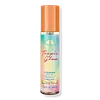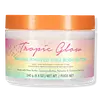What's inside
What's inside
 Key Ingredients
Key Ingredients

 Benefits
Benefits

 Concerns
Concerns

 Ingredients Side-by-side
Ingredients Side-by-side

Carthamus Tinctorius Seed Oil
MaskingIsododecane
EmollientCaprylic/Capric Triglyceride
MaskingIsopropyl Myristate
EmollientParfum
MaskingOryza Sativa Bran Extract
Skin ConditioningBenzyl Alcohol
PerfumingHelianthus Annuus Extract
EmollientPrunus Armeniaca Kernel Oil
MaskingArgania Spinosa Kernel Oil
EmollientRosmarinus Officinalis Leaf Extract
AntimicrobialTocopherol
AntioxidantPelargonium Graveolens Flower Oil
MaskingButyrospermum Parkii Butter
Skin ConditioningLimonene
PerfumingCoumarin
PerfumingBenzyl Benzoate
AntimicrobialCitronellol
PerfumingGeraniol
PerfumingTheobroma Grandiflorum Seed Butter
Skin ConditioningPistacia Vera Seed Oil
Skin ConditioningLinalool
PerfumingCitral
PerfumingPaullinia Cupana Seed Extract
Skin ConditioningCarthamus Tinctorius Seed Oil, Isododecane, Caprylic/Capric Triglyceride, Isopropyl Myristate, Parfum, Oryza Sativa Bran Extract, Benzyl Alcohol, Helianthus Annuus Extract, Prunus Armeniaca Kernel Oil, Argania Spinosa Kernel Oil, Rosmarinus Officinalis Leaf Extract, Tocopherol, Pelargonium Graveolens Flower Oil, Butyrospermum Parkii Butter, Limonene, Coumarin, Benzyl Benzoate, Citronellol, Geraniol, Theobroma Grandiflorum Seed Butter, Pistacia Vera Seed Oil, Linalool, Citral, Paullinia Cupana Seed Extract
Water
Skin ConditioningGlycerin
HumectantGlyceryl Stearate
EmollientCaprylic/Capric Triglyceride
MaskingButyrospermum Parkii Butter
Skin ConditioningPEG-100 Stearate
Pistacia Vera Seed Oil
Skin ConditioningPsidium Guajava Fruit Extract
AstringentTheobroma Grandiflorum Seed Butter
Skin ConditioningCetearyl Alcohol
EmollientDimethicone
EmollientMyristyl Myristate
EmollientAcrylates/C10-30 Alkyl Acrylate Crosspolymer
Emulsion StabilisingSodium Hydroxide
BufferingSodium Chloride
MaskingDisodium EDTA
Parfum
MaskingCaprylyl Glycol
EmollientBenzyl Benzoate
AntimicrobialEthylhexylglycerin
Skin ConditioningBenzyl Alcohol
PerfumingPhenoxyethanol
PreservativeBenzyl Salicylate
PerfumingLimonene
PerfumingCoumarin
PerfumingTocopherol
AntioxidantCI 19140
Cosmetic ColorantMica
Cosmetic ColorantCI 77491
Cosmetic ColorantCI 77891
Cosmetic ColorantWater, Glycerin, Glyceryl Stearate, Caprylic/Capric Triglyceride, Butyrospermum Parkii Butter, PEG-100 Stearate, Pistacia Vera Seed Oil, Psidium Guajava Fruit Extract, Theobroma Grandiflorum Seed Butter, Cetearyl Alcohol, Dimethicone, Myristyl Myristate, Acrylates/C10-30 Alkyl Acrylate Crosspolymer, Sodium Hydroxide, Sodium Chloride, Disodium EDTA, Parfum, Caprylyl Glycol, Benzyl Benzoate, Ethylhexylglycerin, Benzyl Alcohol, Phenoxyethanol, Benzyl Salicylate, Limonene, Coumarin, Tocopherol, CI 19140, Mica, CI 77491, CI 77891
 Reviews
Reviews

Ingredients Explained
These ingredients are found in both products.
Ingredients higher up in an ingredient list are typically present in a larger amount.
Benzyl Alcohol is most commonly used as a preservative. It also has a subtle, sweet smell. Small amounts of Benzyl Alcohol is not irritating and safe to use in skincare products. Most Benzyl Alcohol is derived from fruits such as apricots.
Benzyl Alcohol has both antibacterial and antioxidant properties. These properties help lengthen the shelf life of products. Benzyl Alcohol is a solvent and helps dissolve other ingredients. It can also improve the texture and spreadability.
Alcohol comes in many different forms. Different types of alcohol will have different effects on skin. This ingredient is an astringent alcohol.
Using high concentrations of these alcohols are drying on the skin. They may strip away your skin's natural oils and even damage your skin barrier. Astringent alcohols may also irritate skin.
Other types of astringent alcohols include:
According to the National Rosacea Society based in the US, you should be mindful of products with these alcohols in the top half of ingredients.
Any type of sanitizing product will have high amounts of alcohol to help kill bacteria and viruses.
Learn more about Benzyl AlcoholBenzyl Benzoate is usually created from the condensation of benzoic acid and benzyl alcohol. It is used as a preservative, solvent, and has a floral/balsamic scent in large amounts.
As a preservative, Benzyl Benzoate works against bacteria and fungus. It is often used to treat scabies and lice in medicine.
Solvents are used to keep ingredients together in a product. They can help dissolve ingredients to stable bases or help evenly distribute ingredients throughout the product.
Due to its fragrance, Benzyl Benzoate can be sensitizing and may cause contact dermatitis. It is a known EU allergen. We recommend speaking with a professional if you have any concerns.
Benzyl Benzoate can be naturally found in cranberries and peaches.
Learn more about Benzyl BenzoateThis ingredient is also known as shea butter. It is an effective skin hydrator and emollient.
Emollients help soothe and soften your skin. It does this by creating a protective film on your skin. This barrier helps trap moisture and keeps your skin hydrated. Emollients may be effective at treating dry or itchy skin.
Shea butter is rich in antioxidants. Antioxidants help fight free-radicals, or molecules that may harm the body. It is also full of fatty acids including stearic acid and linoleic acid. These acids help replenish the skin and keep skin moisturized.
While Shea Butter has an SPF rating of about 3-4, it is not a sunscreen replacement.
Shea butter may not be fungal acne safe. We recommend speaking with a professional if you have any concerns.
Learn more about Butyrospermum Parkii ButterThis ingredient is an emollient, solvent, and texture enhancer. It is considered a skin-softener by helping the skin prevent moisture loss.
It helps thicken a product's formula and makes it easier to spread by dissolving clumping compounds.
Caprylic Triglyceride is made by combining glycerin with coconut oil, forming a clear liquid.
While there is an assumption Caprylic Triglyceride can clog pores due to it being derived from coconut oil, there is no research supporting this.
Learn more about Caprylic/Capric TriglycerideCoumarins are a group of substances found naturally in plants. There are over 1300 types of coumarins identified. It has a natural vanilla scent.
Coumarin is an identified EU known allergy, meaning it may cause an allergic reaction when applied to the skin.
In many countries, coumarin is banned as a food additive. However, it can be found in soaps, tobacco products, and some alcohol drinks.
Plants use coumarins as a chemical defense. Some plants that have coumarins include lavender, tonka beans, and yellow clovers.
Learn more about CoumarinLimonene is a fragrance that adds scent and taste to a formulation.
It's found in the peel oil of citrus fruits and other plants such as lavender and eucalyptus. The scent of limonene is generally described as "sweet citrus".
Limonene acts as an antioxidant, meaning it helps neutralize free radicals.
When exposed to air, oxidized limonene may sensitize the skin. Because of this, limonene is often avoided by people with sensitive skin.
The term 'fragrance' is not regulated in many countries. In many cases, it is up to the brand to define this term. For instance, many brands choose to label themselves as "fragrance-free" because they are not using synthetic fragrances. However, their products may still contain ingredients such as essential oils that are considered a fragrance.
Learn more about LimoneneParfum is a catch-all term for an ingredient or more that is used to give a scent to products.
Also called "fragrance", this ingredient can be a blend of hundreds of chemicals or plant oils. This means every product with "fragrance" or "parfum" in the ingredients list is a different mixture.
For instance, Habanolide is a proprietary trade name for a specific aroma chemical. When used as a fragrance ingredient in cosmetics, most aroma chemicals fall under the broad labeling category of “FRAGRANCE” or “PARFUM” according to EU and US regulations.
The term 'parfum' or 'fragrance' is not regulated in many countries. In many cases, it is up to the brand to define this term.
For instance, many brands choose to label themselves as "fragrance-free" because they are not using synthetic fragrances. However, their products may still contain ingredients such as essential oils that are considered a fragrance by INCI standards.
One example is Calendula flower extract. Calendula is an essential oil that still imparts a scent or 'fragrance'.
Depending on the blend, the ingredients in the mixture can cause allergies and sensitivities on the skin. Some ingredients that are known EU allergens include linalool and citronellol.
Parfum can also be used to mask or cover an unpleasant scent.
The bottom line is: not all fragrances/parfum/ingredients are created equally. If you are worried about fragrances, we recommend taking a closer look at an ingredient. And of course, we always recommend speaking with a professional.
Learn more about ParfumPistacia Vera Seed Oil is an oil and isn't fungal acne safe.
Theobroma Grandiflorum Seed Butter isn't fungal acne safe.
Tocopherol (also known as Vitamin E) is a common antioxidant used to help protect the skin from free-radicals and strengthen the skin barrier. It's also fat soluble - this means our skin is great at absorbing it.
Vitamin E also helps keep your natural skin lipids healthy. Your lipid skin barrier naturally consists of lipids, ceramides, and fatty acids. Vitamin E offers extra protection for your skin’s lipid barrier, keeping your skin healthy and nourished.
Another benefit is a bit of UV protection. Vitamin E helps reduce the damage caused by UVB rays. (It should not replace your sunscreen). Combining it with Vitamin C can decrease sunburned cells and hyperpigmentation after UV exposure.
You might have noticed Vitamin E + C often paired together. This is because it is great at stabilizing Vitamin C. Using the two together helps increase the effectiveness of both ingredients.
There are often claims that Vitamin E can reduce/prevent scarring, but these claims haven't been confirmed by scientific research.
Learn more about Tocopherol